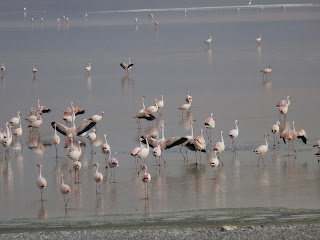We pulled into La Paz at 6am. The bus journey was probably along terrifyingly precarious cliff faces but due to the majority of it being through the night we spent a relaxing time, heads lolling around, snatching 2 minute microsleeps in between potholes and comfort breaks.
La Paz is Bolivia's administrative capital and is built at about 3600m above sea level in a valley surrounded by impressive mountains with red brick barrios balanced perilously on sheer cliffs emanating from its humble central business district. Despite its Spanish colonial history it has suffered from a pretty depressing economic climate and as a result many of these old buildings have been torn down due the inability of the owners to afford the upkeep. As a result the centre looks a lot more industrial and stoic than other Latin American capitals.
Our hostel's check in wasn't until 1pm so we dumped our bags and went for a wander around the centre of town.
La Paz is Bolivia's administrative capital and is built at about 3600m above sea level in a valley surrounded by impressive mountains with red brick barrios balanced perilously on sheer cliffs emanating from its humble central business district. Despite its Spanish colonial history it has suffered from a pretty depressing economic climate and as a result many of these old buildings have been torn down due the inability of the owners to afford the upkeep. As a result the centre looks a lot more industrial and stoic than other Latin American capitals.
Our hostel's check in wasn't until 1pm so we dumped our bags and went for a wander around the centre of town.
Unlike Rio and Buenos Aires the atmosphere wasn't one of extreme poverty and dicey street crime despite Bolivia being one of the countries in South America with one of the lowest average wages and we wandered around taking it all in. One of the old cobbled streets we ended up meandering along sold an eclectic collection of tourist tat including, among other things, a full range of Al Paca wool clothes, pan pipes, bowler hats and Llama foetus. Dried Llama foetus is commonly bought by proud home owners to bury under the front of your house to ward off evil spirits. Maybe it works, maybe it doesn't but definitely one of the most aesthetically frightful things people around the world put their faith in.
Whilst holding up one of the petrified llamas staring at it, glassy eyed, we started to hear what sounded very much like explosions echoing through the valley. They were far too loud to be a car backfiring and we assumed that some ropey city centre establishment had exploded in a fire ball due to a gas leak or some other avoidable disaster. When it happened again, we became a little concerned but when it kept happening and we saw everyone around us casually going about their daily business we realised that whatever it was did not seem to be causing undue alarm. We asked one of the shop owners what the noise was and he answered 'manifestacion' which means protest. I asked where it was happening and he pointed down to the main street we had just come from. We walked back down the hill a little and were greeted with quite a sight.
The main street we had crossed an hour before was now packed with thousands of people who, we found out later, were protesting the absolutely horrific conditions that the miners in Bolivia have to endure every day. This was particularly poignant having just arrived from Potosi, home of the mine known locally as 'The Mine that eats people'. The explosions we'd been hearing were the miners detonating dynamite on main shopping street in La Paz. The protesters seemed to be divided into different unions, or mines. Each section had its own flag at the front of the group and each group would light a stick of dynamite at what seemed to be completely random intervals before sprinting away from the fizzing explosive before the blast sent out a shockwave that would physically knock the wind out of you and leave your ears ringing as you stood there bewildered, wondering what had just happened.
We eventually learnt that when you saw people with their fingers in their ears running for cover, you should probably do the same thing. The comparison between the protest we were witnessing here and those you see back home in the UK or here in NZ was so far removed as to be almost a different thing altogether. Whilst this was happening I think I saw 4 policemen standing in a doorway smoking with their backs to the protesters. Compare this to the hundreds of police you see back home sent out in full body armour to deal with a tenth of the number of protesters, most of whom are shrieking female students with dreadlocks it makes you wonder who's democratic rights are more developed.
These protests were to be an ongoing part of our time in La Paz and the Policia weren't always as placid as the ones we saw on that first day but the ubiquitous dynamite, along with the highly repetitive indigenous pan pipe music were to become the soundtrack of La Paz for the rest of our stay.
Probably the most stimulating arrival to a city we'd experienced to date, one that fits perfectly in with Bolivia, a country of incredible extremes and a country we were rapidly growing to love.































